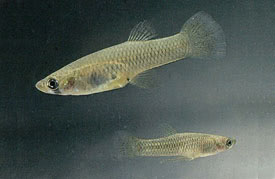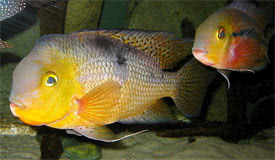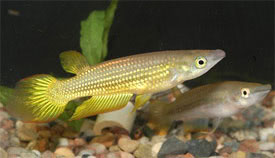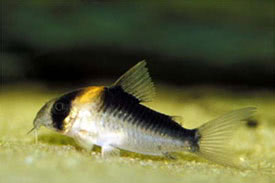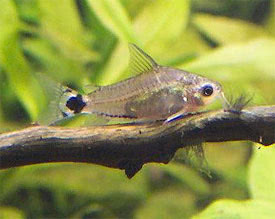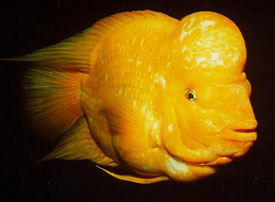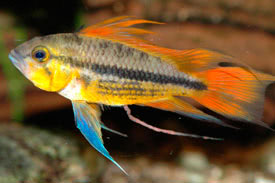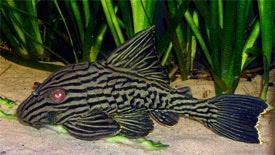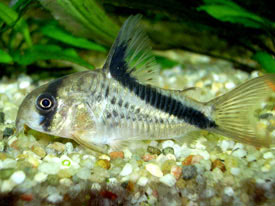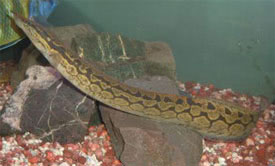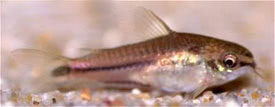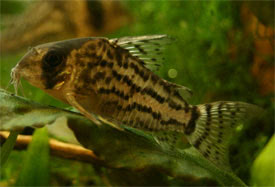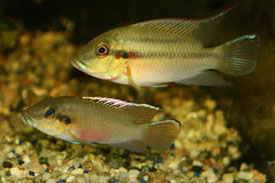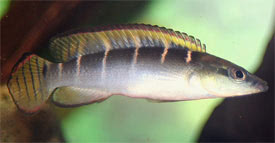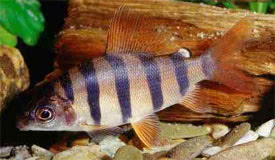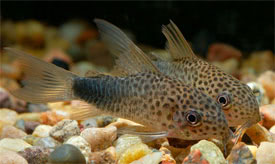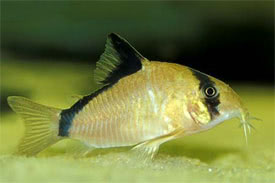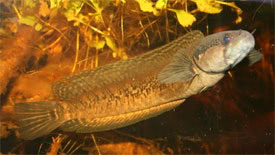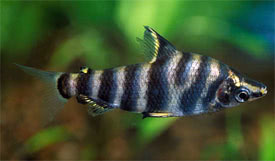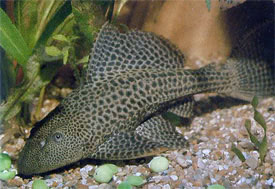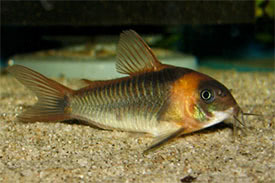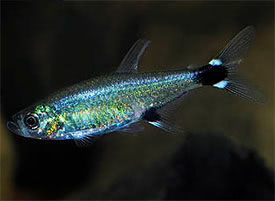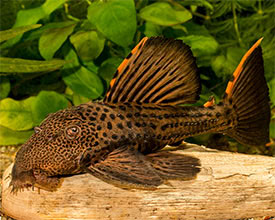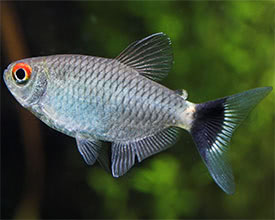Gyrinocheilus aymonieri - Siamese algae-eater
 Magyarul / Hungarian
Magyarul / Hungarian

 Magyarul / Hungarian
Magyarul / Hungarian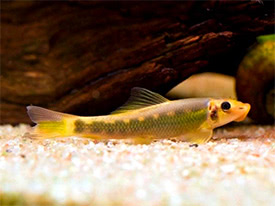


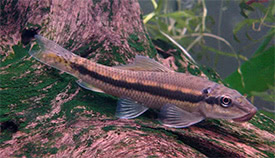
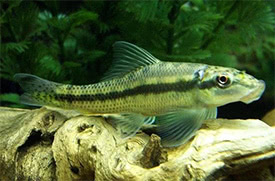
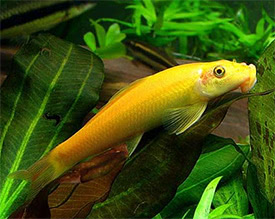
- Scientific name: Gyrinocheilus aymonieri
- Synonyms: Psilorhynchus aymonieri (Tirant, 1883), Gyrinocheilus kaznakovi (Berg, 1906), Gyrinocheilus monchadskii (Krasyukova & Gusev, 1987)
- Common name: Siamese algae-eater
- Group: Cyprinids
- Distribution: Southeast Asia; Thailand, Laos, Cambodia and Vietnam.
- Size: 20-28 cm
- Biotope: Inhabits flowing rivers and streams with sandy and rocky substrates, often around submerged tree roots. Because of the shallow water and bright sunlight, a rich biofilm and algae cover forms over the submerged surfaces upon which the fish browse.
- Social behavior: Mostly unsuitable for the general community aquarium, tankmates must be chosen with care. Small specimens tend to hide away, but as they grow older they become more territorial and aggressive towards conspecifics and similar-looking species. Other bottom-dwelling fishes (like cichlids and catfish) are best avoided as they may too be picked on. Choose robust and fast-swimming tankmates that dwell in the upper water levels, or in a very large tank a small group can be kept together where they will develop a pecking order and the aggression will reduced between the fish.
- Diet: Omnivorous; Primarily an aufwuchs grazer feeding on algae, small crustaceans and biofilm in nature. A very effective algae eater in the aquarium, but when there are not enough algae, it will eat all kinds of live and frozen foods along with good quality dried foods. As they mature, their dietary preferences begin to shift toward meatier foods.
- Breeding: Not possibble in aquarium.
- Tank: Minimum 300 litres
- Population: 1 fish for 300 litres
- Decoration: When sufficient hiding places are available this species is relatively unfussy in terms of décor, and should not harm softer-leaved plants. Best kept in an aquarium that designed to resemble a flowing river with river sand or small gravel substrate, and decorate the tank with larger rocks that create lots of hiding places. The water-flow can be strong. The aquarium can be further decorated with aquarium plants which can be grown attached to the decor. They are intolerant to the accumulation of organic wastes, and require a high level of dissolved oxygen, therefore regular water changes are essential.
- Temperature: 22-26 °C
- pH: 6.0-8.0
- Hardness: 2.0-20.0 dGH
- Lifespan: 10-15 years
Description: The Siamese Algae Eater has an elongated, cylindrical body and the mouth is located on the underside of the snout, that forms a sucking disk perfect for anchoring to hard surfaces even in fast-moving water. They have a yellowish-brown, or greyish-green body color with a notable brownish-black stripe from the tip of the snout to the tail, and this stripe is often broken. They also have yellow eyes. The fins are transparent, but there can be black spotting at the base of the dorsal and tail fins. The back is a darker brown color, while the lower parts are silvery-white. Gyrinocheilus aymonieri possess a small, spiracle-like aperture at the top of each opercle, which are used as secondary respiratory openings through which water enters and passes over the gills before being expelled via the principal gill opening, so mouthparts can be used independantly for feeding and anchoring to solid surfaces. Unlike many cyprinids, they do not have barbels.
This species is among the most well-known fishes in the aquarium trade but juveniles are typically being offered for sale with little to no information regarding temperament, adult size, and potential age. There also exist several ornamental strains including albino, golden, or marbled. The golden variety is sometimes subjected artificial dying, an undoubtedly painful process which involves injecting the fish with coloured dyes and normally leads to a significant reduction in lifespan. In its native countries, it is used as a food fish, and can be often seen in fish markets. An aquarium with base dimensions of 150x45 cm should be the smallest to keep them.
Sexually mature females are noticeably fuller-bodied than males, but it is impossible to sex juveniles accurately. Males develop noticeable tubercules on the head and snout.
Perhaps they can be bred in huge tanks with the aid of hormones, but their breeding in a home aquarium is not possible. This could be because of something is missing in their diet, that they can get in nature, or the lack of seasonal changes in the home aquarium. The other reason could be that they can't reach sexual maturity even in a huge tank.
Sources:
https://www.fishbase.se/summary/12298
https://www.seriouslyfish.com/species/gyrinocheilus-aymonieri
https://animal-world.com/encyclo/fresh/cyprinids/chinesealgae.php
https://fish.mongabay.com/species/Gyrinocheilus_aymonieri.html
https://en.wikipedia.org/wiki/Gyrinocheilus_aymonieri
https://www.fishbase.se/summary/12298
https://www.seriouslyfish.com/species/gyrinocheilus-aymonieri
https://animal-world.com/encyclo/fresh/cyprinids/chinesealgae.php
https://fish.mongabay.com/species/Gyrinocheilus_aymonieri.html
https://en.wikipedia.org/wiki/Gyrinocheilus_aymonieri
Hasonló vízparamétereket igénylő fajok




